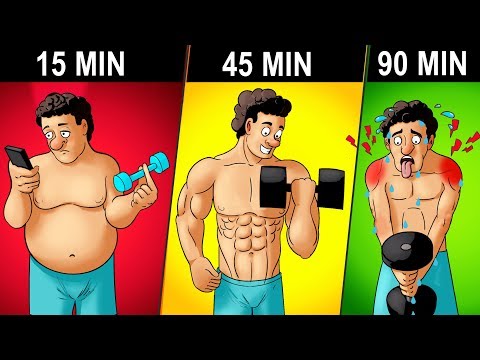
How long should your workouts take to see the best results? Does working out for longer than 45 minutes diminish muscle growth and fat loss due to hormonal changes? Or is this a myth? Find out what the scientific evidence has to say about exercised induced changes to testosterone and cortisol, and if there really is an optimal workout length for building muscle and burning fat.
? FREE Diet/Workout Calculator:
? 6 Week Fat Loss Challenge:
? 12 Week Lean Bulking Program:
?? If you want to train with me directly to transform your body as fast as possible, fill out a training application and see if you qualify here(???, ??????, ??? ?? ????):
How long should you work out during each training session? Is there actually a time limit for your workouts that you don’t want to exceed. After all, I’m sure you’ve heard some people say that that working out for longer than 45 minutes to an hour will have a negative effect on your hormones, and do more harm than good, ultimately limiting your progress. Meanwhile, others say that there’s no need to worry so much about overtraining and the more time you put into your workouts the faster results you’ll get. So which one is it? Well, that’s exactly what I want to go over in today’s video. And not only will I provide my personal suggestions, but I’ll also go over exactly what the scientific research has to say on this topic. So let’s start first with the very common belief that you should never exceed hour-long workouts and preferably even keep your workouts under 45 minutes. This idea is mostly based around what happens to hormones like testosterone, growth hormone, and cortisol during exercise. When you start working out your body will respond by naturally boosting testosterone levels and the theory is that this boost is supposed to help improve our performance, help us build muscle to a greater degree, and it’s also supposed to help us burn more fat… So far so good, however, the idea is that after around 45 minutes your Cortisol levels will start rising while your testosterone levels start dropping putting your body into a catabolic mode where you’re more likely to breakdown muscle tissue for energy, and store more body fat. So exercising past the 45-minute mark was always thought to be at best a waste of time and at worst something that could undo all your hard work at the gym. Now, is there any truth to this? Well, there have been a couple studies that looked at this topic directly and one of the first ones was a small study back in 2001 that involved a small sample size of only 16 men. The researchers divided these men into two groups. One group only trained one arm for 9 weeks. While the other group trained their arm the same way, but also included 8 sets of Legs at the end of their arm workouts, to stimulate more testosterone and growth hormone to be released. Sure enough, after each workout, blood tests showed that the group that also trained their legs experienced higher spikes in testosterone and growth hormone levels. And At the end of the 9 weeks, the group that worked both their Arm and legs increased their strength in their trained arm by a whopping 37 percent while the group that only worked their arm without training their legs increased their arm strength by only 9 percent. So this study clearly showed that you should ideally limit your workout length to that first 45 minutes while testosterone and growth hormone is elevated since in this study it led to more gains……… or did it. Well, it actually turns out the study was flawed. The participants in the leg’s and arms group started off 20 to 25 percent weaker than the participants in the arm only group, giving them the opportunity to take greater advantage of newbie gains leading to a greater change in their strength levels throughout the study. (1) So it was ultimately inconclusive
————-
References in the video:
1. Acute changes in anabolic hormones while training seem to increase strength but: “due to the initial difference in isometric strength caution must be taken with the interpretation of this finding”https://www.ncbi.nlm.nih.gov/pubmed/11782267
2. “exposure of loaded muscle to acute exercise-induced elevations in endogenous anabolic hormones enhances neither muscle hypertrophy nor strength with resistance training in young men”
3. “exercise-induced systemic hormonal responses of cortisol and GH are weakly correlated with resistance training-induced changes in fibre CSA and LBM”https://www.ncbi.nlm.nih.gov/pubmed/22105707
4. “What seems relatively clear from the literature is that ifa relationship does in fact exist between acute systemicfactors and muscle growth, the overall magnitude of theeffect would be fairly modest”https://www.ncbi.nlm.nih.gov/pubmed/23442269






